Heading out the door? Read this article on the new Outside+ app available now on iOS devices for members! Download the app.

The more weight-bearing, dynamic, and repetitive an exercise is (hey, vinyasa yoga), the more crucial shoulder stability becomes. Learn the anatomy and understand the actions necessary to prevent injury in your body’s most vulnerable joint.
Plus, join Tiffany Cruikshank at Yoga Journal LIVE San Francisco, January 13-16, 2017. Get your ticket today.
A Shoulder Girdle Epiphany
Having once been heavily immersed in the Anusara yoga method, I spent my first six years of asana practice “melting my heart.” I took pride in my ability to soften (or rather collapse) the place between my shoulder blades—creating the deepest trench possible along my thoracic spine—when in reality I was just playing into and relying on my hypermobility.
I experienced a profound shift in both my practice and understanding of asana when someone taught me how to protract my shoulder blades in preparation for Handstand. Protraction is essentially the opposite action of “melting your heart,” which requires a passive retraction of the shoulders. By pushing down through my hands and up through my back, I was able to find a lot more stability through my shoulder girdle and make Handstand much more accessible.
More importantly, I began to recognize that my shoulders’ hypermobility on the mat was the culprit for a lot of the discomfort and injuries I was encountering off the mat. For the past few years, my yoga practice has become mostly about finding stability, not only in my shoulders but in all of the hypermobile areas of my body.
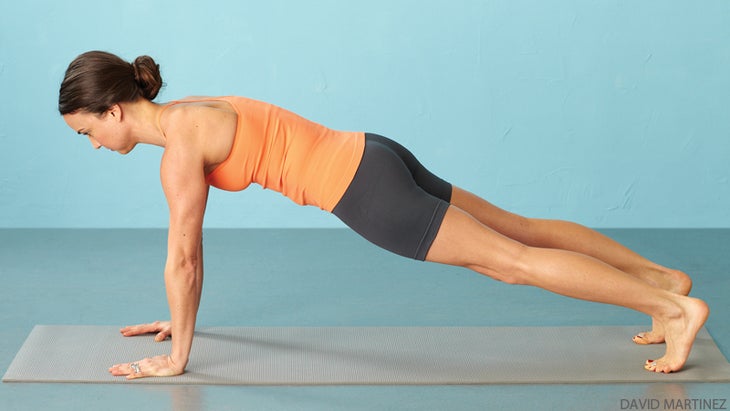
I recently had the privilege of studying with Tiffany Cruikshank for the first time. We spent an entire day exploring the shoulder joint in her Master Series for Teachers at Yoga Journal LIVE! San Francisco. I was thoroughly impressed by her vast knowledge, extensive experience, and mostly her ability to break down and teach anatomy and biomechanics in an accessible, non-dogmatic way. Plus, her playful sense of humor kept the intensely heady day light and the information digestible.
By the end of the workshop, my understanding of the shoulder girdle as well as how to create—and teach—shoulder stability had deepened once again. The biggest takeaway: The more weight-bearing, dynamic, and repetitive an exercise is (hey, vinyasa yoga), the more crucial shoulder stability becomes.
See alsoHow to Strengthen Your Shoulders and Avoid Injury
The Importance of Shoulder Stability In Risk of Injury
The shoulder is the body’s most mobile joint. Unfortunately, the more mobile a joint, the less stable; and the less stable a joint, the greater the risk for injury.
The shoulder girdle’s remarkable mobility is partly owed to the fact that the shoulders are actually two joints: the glenohumeral joint, where the arm bone fits into the socket of the shoulder blade creating a very shallow ball-and-socket joint, and the AC (acromioclavicular) joint where the shoulder blade attaches to the collarbone creating a gliding joint. Together the two joints allow us to raise, lower, and rotate our arm bones as well as to move the shoulder blades on and off the back.

Given its instability, the shoulder is also the most commonly dislocated joint in the body (one of the reasons why creating stability there in weight-bearing exercises is so important); however, it’s more often the general wear and tear on the various layers of soft tissue within the joint that lead to injury—including strains, tears, chronic inflammation, and impingements—in a regular (i.e., repetitive) yoga practice.
Wear-and-tear injuries are generally the result of dysfunction somewhere within the shoulder girdle. Something is too tight, too weak, or out of alignment, affecting the optimal joint position and placing unnecessary tension elsewhere. When the shoulder joint isn’t positioned properly, and then asked to perform repetitive, weight-bearing exercises, a number of injuries can occur. Labrum tear, bursitis, and rotator cuff strains or tears are a few of the injuries yoga teachers hear about most often. These risks make it especially important to learn how to actively stabilize both moving parts—the head of the arm bone (or humeral head) and the shoulder blade (or scapula).
Also seeTiffany Cruikshank’s 9 Poses to Keep Athletes Injury-Free
Get to Know the Muscles of Your Rotator Cuff
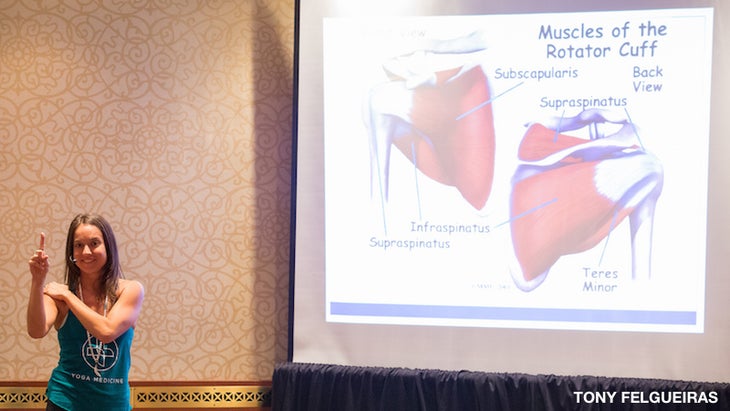
Enter the rotator cuff, a group of muscles and their tendons that literally create a continuous cuff around the shoulder joint, to help keep the humeral head in the shoulder socket. Together, the four muscles on the front, back, and top of the joint negotiate the position of the head of the arm bone in the shoulder socket. That means all three sides of the rotator cuff need to work as a community to stabilize the shoulders. If one muscle of the four is tight or weak, the others have to compensate—creating an imbalance, which can lead to strains and tears in the rotator cuff and compromise the stability of the shoulder joint.
See alsoOpening Tight Shoulders
The Subscapularis: Internal Arm Rotation
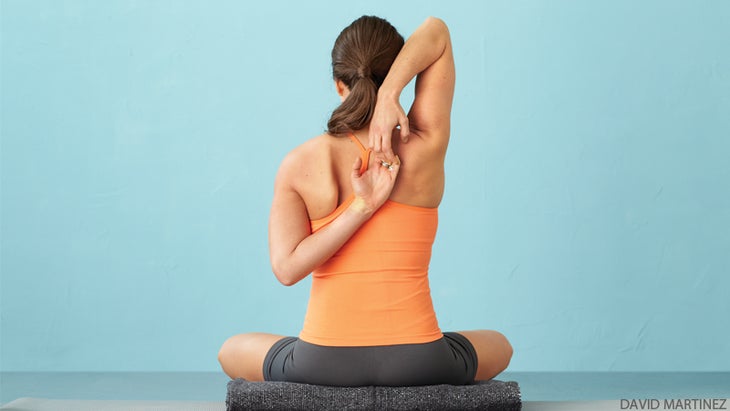
THE MUSCLE The subscapularis is the muscle on the front side of the shoulder blade.
THE ACTION Internal rotation of the arm bone, or turning the arm in. It can be felt as a contraction very deep in the armpit. You might hear these muscles referred to as your “armpit muscles.”
WHEN TO USE IT Certain arm variations, such as Prayer (Anjali Mudra) behind the back and the bottom arm in Gomukhasana (Cow Face), require internal rotation of the head of arm bones.
TRY IT Standing in Tadasana (Mountain Pose) with your arms down at your sides, palms facing forward, spread your fingers to activate your hands and arms. Now turn your arms in so the palms first face your sides and then turn backward, bringing the outer arms forward.
The Infraspinatus + Teres Minor: External Rotation
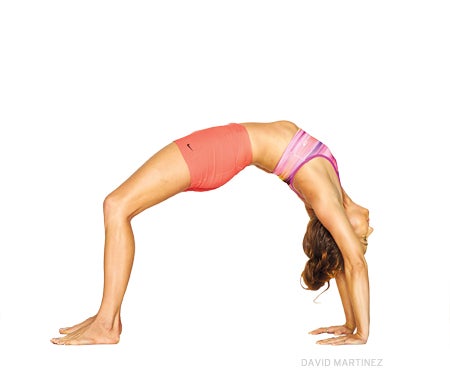
THE MUSCLE The infraspinatus and teres minor are the muscles on the backside of the shoulder blade. They work together as a team.
THE ACTION The infraspinatus, with the help of the teres minor, is responsible for external rotation of the arm bone (turning the arm out), which can be felt as a slight contraction on the backside of the shoulder blade.
WHEN TO USE IT For starters, whenever we raise our arms overhead in poses like Warrior I (Virabhadrasana I) and Tree Pose (Vrksasana), we externally rotate the heads of the arm bones wrapping the triceps forward to make space along the sides of the neck and release unnecessary tension in the traps. Extended Side Angle Pose (Utthita Parsvakonasana) requires a strong external rotation of the top arm bone to turn the pinky side of the arm down and thumb side up. It’s also important to maintain external rotation of the head of the arm bone in weight-bearing poses like Downward-Facing Dog (Adho Mukha Svanasana), Handstand (Adho Mukha Vrksasana), and Upward Bow Pose (Urdhva Dhanurasana) to maintain proper alignment and support.
TRY IT Standing in Tadasana with your arms at your sides again, bend your left elbow 90 degrees pointing the fingers forward. Make a fist with your palm, keep your elbow at your side, and open your fist and forearm out to the left by externally rotating the head of the arm bone.
The Supraspinatus: Arm Lifting
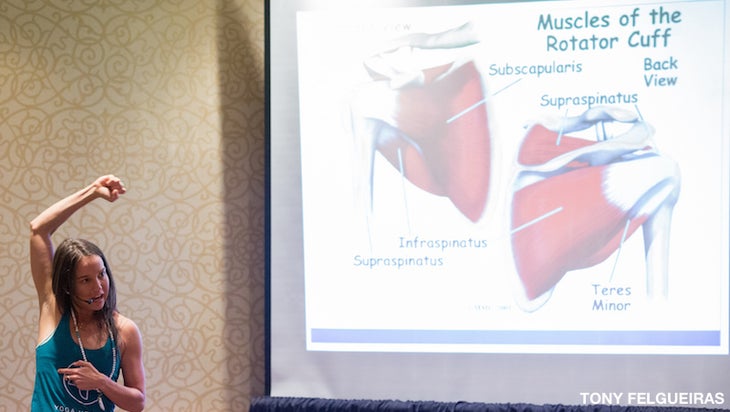
THE MUSCLE The supraspinatus sits on the topside of the shoulder blade and attaches directly to the head of the arm bone.
THE ACTION Holding the head of the arm bone into the shoulder socket, against the downward pull of gravity, and assisting the deltoids in lifting the arms overhead are the work of the supraspinatus.
WHEN TO USE ITWhenever you raise your arms out and up, your supraspinatus initiates the lift before the deltoids take over, whether that’s in Warrior I or II, or any number of poses that require a lift of your arms.
TRY ITStanding in Tadasana with your arms down at your sides lift your arms out to a T shape.
See alsoPoses to Protect Your Rotator Cuff
Get to Know the Shoulder Blade–Stabilizing Muscles

Although considerably less mobile, the shoulder blades, or scapulas, also must be actively stabilized in weight-bearing exercises. The two muscles that negotiate the placement of each scapula on the back are the serratus anterior and the rhomboid. Both muscles insert on the inner edge (or medial border) of the shoulder blade and have opposing actions. When these muscles are equally turned on, they work together to stabilize the shoulder blade on the back.
The Serratus Anterior: Scapula Protraction
THE ACTION Protraction pulls the shoulder blades off the back toward the ribs, away from the spine.
WHEN TO USE IT Think of what happens to the shoulder blades when you round the upper back like in Cat Pose (Marjaryasana).
TRY ITBegin on all fours—wrists under shoulders, knees under hips. Press down into your palms, rounding your spine toward the ceiling and looking in toward your belly. Notice how the shoulder blades pull off the back, as well as the strong engagement in the sides of your ribs where the serratus anterior (which is now turned on) attaches. This is protraction.
The Romboid: Scapula Retraction
THE ACTION Retraction pulls the scapulas onto the back toward the spine.
WHEN TO USE ITThink of what happens when you arch your back in Cow Pose (Bitilasana), dropping your chest toward the floor.
TRY ITFrom Cat Pose, lengthen your heart and gaze forward and up, letting your belly and chest drop toward the mat. Notice how the shoulder blades are coming together toward the spine. This is retraction. Play with protraction and retraction in Cat-Cow Pose until you are familiar with the actions. When you’re ready to find neutral spine, fully protract and retract and then look for the place in between where neither action dominates.
NEXT Now that you are familiar with your shoulder anatomy, learn how to stabilize the joint: Tiffany Cruikshanks’ 4 Steps for Shoulder Stability in Weight-Bearing Poses
See alsoYoga to Correct Muscular Imbalances